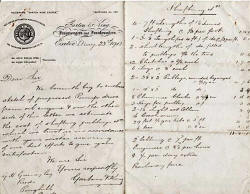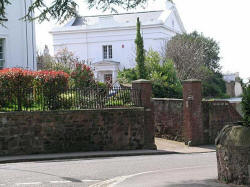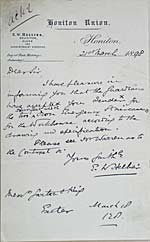

It’s 1900, a hot August where in Britain a scorching 99 degrees Fahrenheit has been recorded. Queen Victoria is still on the throne, the Boxer Rebellion is in full swing and the Second Boer War was going none too well for the Empire. The Queen Mother (Queen Elizabeth) is not even two weeks old and the Musical Comedy ‘The French Maid’ is playing at Exeter’s THEATRE ROYAL.The Motor Car was a plaything of the rich and well heeled, the Railways were spread over much of the country but the horse still reigned supreme on the highways and byways.
Across in Michigan in the city of Kalamazoo an infestation of Grasshoppers stopped trains running and even closed businesses - not many people remember Kalamazoo for this - mostly remember the Glenn Miller song “I Gota Gal in KALAMAZOOOOOO”
 A May 1901 Letter, still showing the Partners’ Names. The letter is addressed to G. H. Gurney in Bude. He was the inventor of, amongst other things, the GURNEY STOVE - at least one was installed in Exeter Cathedral. See HEATING  John Gould King’s home at the time of his death was Belle Vue House. It still stands today opposite Palmers Almshouses at the end of Denmark Road. Now divided into flats, the name Belle Vue has lapsed in favour of Numbers - when I approached the neighbours a year or so ago none of them recognised the name.. |
Garton & King were going through a bit of managerial turmoil at the time; not, however, caused by any infestation (grasshoppers or otherwise) but by the unexpected death of Mr Gould King, the senior partner, at the age of 72 in March of 1900. This put Hugo Holladay, who joined Mr King as Junior Partner on the 1st October 1898, in a bit of a fix - he knew everything about Ironmongery but nothing about running a foundry - this had been left in the competent hands of Mr Gould King! Unfortunately it seems that Mrs King wasn’t too pleased at loosing a husband and indications exist that suggest Mrs King and Mr Holladay perhaps got off on the wrong foot!
The week commencing the 20th August.
Upstairs in the Wages Department of Garton and King’s Ironmongery Shop at 190 High Street, Exeter.
The Wages clerk has just completed the handwritten entry on the page headed “Time and Wages Week Ending 17th August 1900” in a large leather bound ledger. The size of each page measures some 10" wide and some 16" top to bottom, the whole ledger weighs nearly 8lbs and is one of a range of Account Books manufactured by the well known firm of A Wheaton & Company whose premises are just down the road at 185 Fore Street.
There are some 30 employees listed and they work, with the exception of four of them, a six day week. Saturday working involves around 6 hours but the Monday to Friday paid hours are between 9½ hours and 12 hours per day. There are a few weekly salaried staff, the highest paid being 10 shillings and the hourly rates of pay per hour for the remainder of the workforce commence at 3d per hour and rise to the highest paid at 6¼d per hour.
In the week ending the 17th there are five members of staff who have had to travel to places of work other than the Shop and Foundry.They use the train to get to their temporary places of work and their rail fares are entered and claimed for in “Expenses”. They have been sent to work at a variety of places. Mr A Cornelious was sent on three occasions to the Honiton Union and on one occasion to Colonel Smee to work. Mr Melhuish attended work at Eggesford House, or on the Estate, for Lord Portsmouth and appears to have claimed for a cart from the station at Eggesford (materials would have been sent by train) and other members of the workforce attended the Axminster Union, a Colonel Davis and Mr Hugo Holladay, the Managing Director, went by train to Eggesford to Lord Portsmouth’s estate for 4/6d Return Fare (First Class no doubt!) and also to Honiton (3/-) and Axminster (5/9d) during that week.
 HONITON UNION Contract for 2 Emergency Staircases dated March 1898 |
It‘s worthwhile deviating slightly and putting these fares into context. The first class Return Fare to Eggesford represents, to many of the then workforce, about a 25% of their regular weekly wage - a First Class Return nowadays cannot be bought - indeed a seat cannot be guaranteed, but the Day Return now represents, at £7.40, a mere 2.5% of the average weekly wage in 2012 of someone in the Hotel and Catering trade averaging about £300 per week, or, in other words about an Hours Pay - Train Fares are considerably cheaper than they used to be!
The total Wages Bill for the week ending 17th August came to £32.07.02d and expenses (the majority of which were Rail Fares) came to £1.14.09d
Very usefully at the end of the Wages Ledger (which covers the period August 1900 to August 1909) is a list of Staff Members and their addresses. What is interesting to note is not only the fact that the names of some crop up twenty, forty and even sixty years later as the sons follow their fathers and close relatives into the Company, but the numbers employed at the end of July 1923 have increased by only four but the daily hours of work have reduced to between 7 and 8 hours a day but it is still a six day working week. Unfortunately only the timesheets exist for 1923 and there is no record as to how the Rates per Hour have altered.
It is hard to introduce a bit of humour into this Chapter - we are in the era of hard graft and lean pay, a six day working week; conditions at the place of work somewhat more primitive than we take for granted today - the foundry was dirty, smelly, noisy and dangerous, the Ironmongers shop was cluttered but perhaps warmer and brighter. On the bright side any staff toilets may have had the ‘convenience’ of being equipped with the relatively new Toilet Paper on a Roll, patented by a Philadephia Firm Scott Brothers in 1870 and which came to our shores in the 1880s. Bookkeeping was all completed by hand in ledgers on raised desks in pen and ink. Letters were handwritten (though typewriters, including those with a QWERTY layout were by now making an appearance) and mental arithmetic reigned supreme. In monetary terms everything was in good old fashioned pounds, shillings and pence; there were at least ten different values of coin in daily use and goods were also valued in guineas.
More information about Staff employed by the company can be found on the Workforce page.
I have attempted to brighten up this article with a few illustrations but I have reproduced the Staff Wages List and Addresses so that Google can, in time, work its Magic and guide searchers to this site. It is also hoped that anyone who can trace their family roots to the Exeter area or who can claim long standing family ties with Exeter or interested in Exeter’s History may benefit from the above information. Some of the locations have changed and disappeared in the last hundred years but maps of the period do exist, and the Westcountry Studies Library is a useful source. I don’t think I have breached any rule or regulation by giving out addresses as the persons I am referring to will be long dead and gone but the information may help the Family Historian or Genealogist reading this article.
Following on from this New Chapter is one devoted to some of the interesting places the Company performed work at and the varied and unusual work that was carried out.
Don’t forget! - if you have any comments or suggestions then please visit the Guestbook or contact me through the About Me page.
See also:
Was 1900 a good year? — Personalities
Workforce at work — Banking, Payment and Tokens
Sitemap / Contents